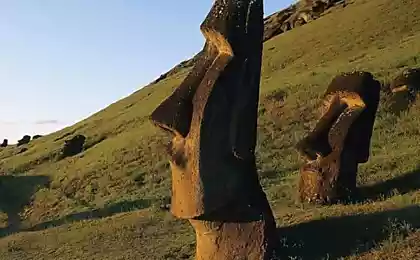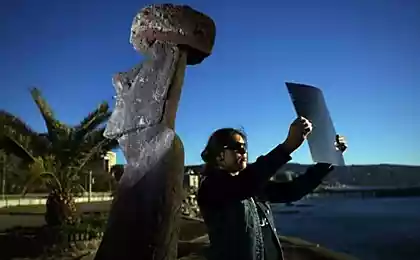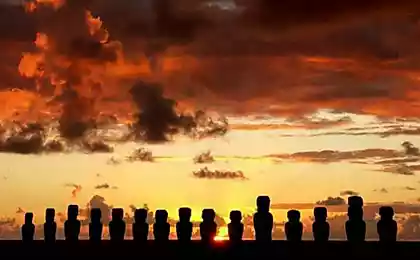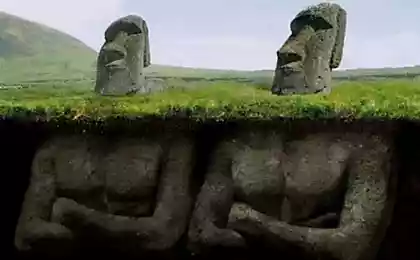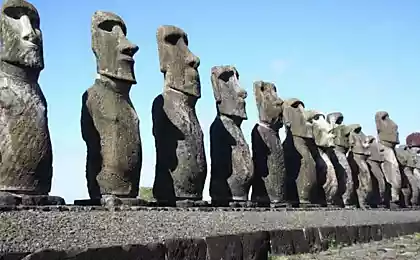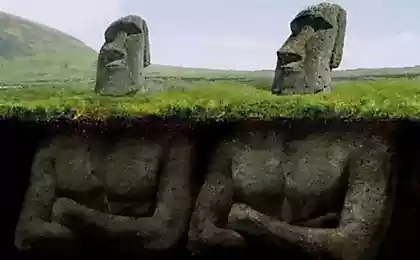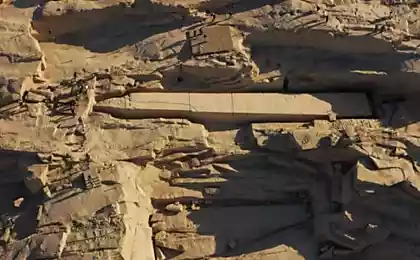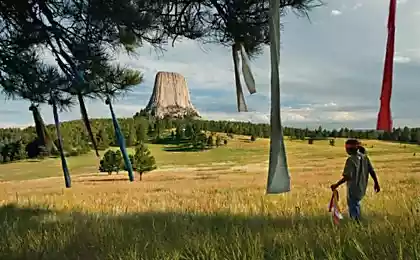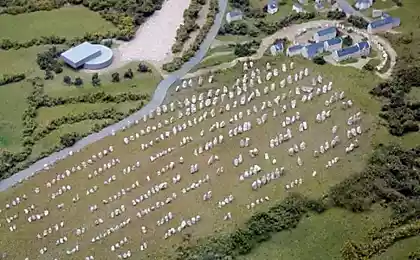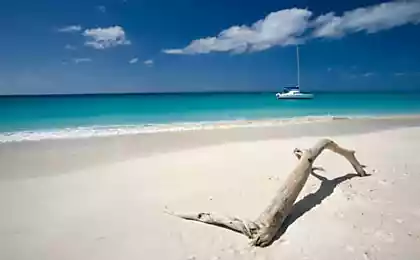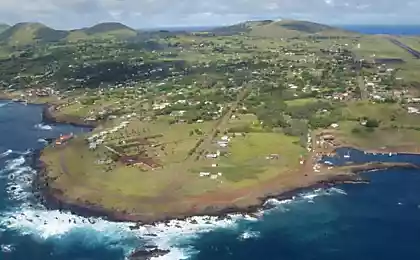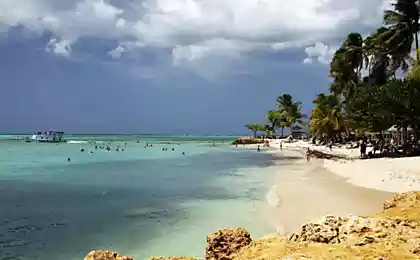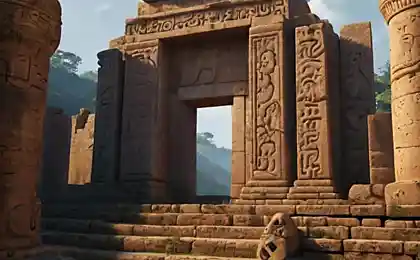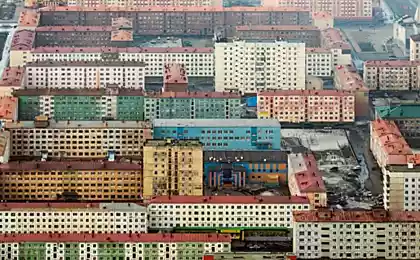1268
The truth about the Moai
The history of mankind, in contrast to his own geography, still contains a considerable number of white spots.
Sometimes even a small piece of land in front of people putting puzzles more than can fit in the memory of earthly inhabitants.
For example not far to seek - to 3703km from the coast of South America to the east and 1819km from the nearest inhabited islands in the west is a small triangular shaped island with an area of only 165 square kilometers.
The island has three native title - Te Pito-te-Hen, which means "Navel of the Islands", "Rapa Nui" ("Great Rapa"), and the third - "eyes looking at the sky", in the original - Mata- Kite-Rani.
Europeans piece of land called Easter Island ...
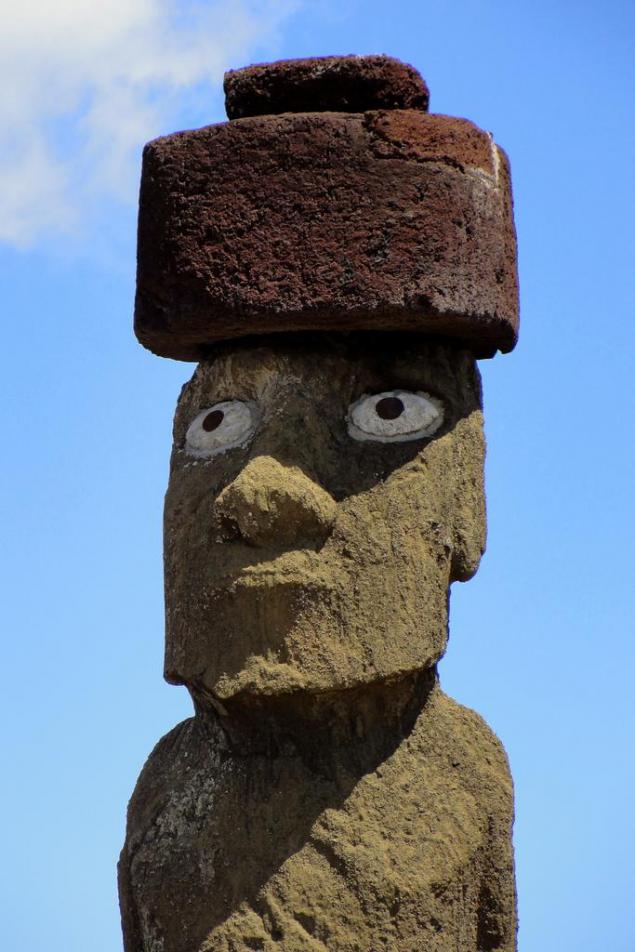
The most prominent landmark of this land is famous all over the world sculptures stone idols - moai. Total articles 997 and their appearance is so peculiar that the impressive size of the head, placed on the frail calf, the person Weighted powerful chins and long ears, can not be confused with any other human creations. Some sculptures flaunt tysyachekilogrammovymi hats red. Despite the fact that the secrets of the quarries haunt people almost since the opening of the Easter Island, despite the presence of many original and ingenious theories, their purpose, the main issues relating to the moai, are still on the agenda: who, when, and most importantly, why I created them as multi-ton sculpture was delivered to the installation site and why they were defeated?
Who portrayed idols?
On this question, as to the question: who are devoted to the image, modern science has no exact answer. The indigenous people have lost their historical memory. In addition, almost all of the indigenous people of the island have become extinct in the 19th century, during an epidemic of smallpox, brought here from the continent. There is a theory that served as statues, tombstones, ie They are the guardians of the dead and portrayed the deceased ancestors. Other theories see tall sculptures devices for maritime orientation, because the island devoid of trees, the statues are clearly distinguishable from a distance. Someone even projected location of the moai on the star map and considers them astronomical signs. In any case, none of the theories to this day completely unproven.
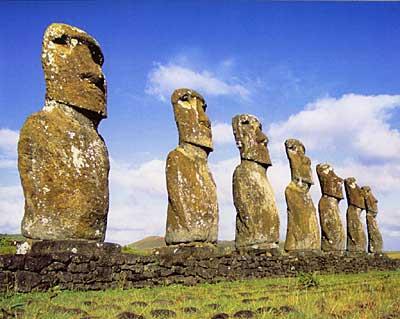
Probably, like most religious objects, the purpose of the idols varies with time. Moai older were most likely images of the local gods. This is indicated by their similarity to the stone statues of Polynesian inhabitants of the Marquesas Islands. Since the 14-15th c, sculptors have settled the island in a manner began to sculpt their rulers, leaders of clans, commanders, priests and other prominent locals. That is not the image of a god or a person proves the existence of a proper name of each idol. For certain deciphered today a little more than 50 names moai. The name could be given to the statue no matter whom it represented: human spirit or god. And it could coincide with the name of the manufacturer of the sculptor sculpture. In those cases, when given at birth name was forgotten, the statue was called or common notions of "Statue of god", "Statue of sorcerer" and so on. E., Or by location, or sculptural features: "The statue near the house," "Direct moai" and etc.
Same or different?
One does not doubt in riddles idols: whoever statues were not considered as they are, no doubt, have been cult figures. The cult reigned Moai on Easter Island from 12 to 17vv. During the reporting period, a lot has happened: have changed the destination application figures, even their appearance. Constructed statues at different times differ considerably from each other in their anthropometric parameters: the shape, height and width.

The oldest statue did not exceed the height of human growth, and were made of basalt. They have very little to do with the canonical sculptures of a later period, except that the location does not change hands for centuries. Over time, these basalt products stopped all play a role in the minds of the locals, they were often used as a building material and maintenance ceremonial ahu platforms. Ahu are flat or slightly sloping to the sea area in length from ten to one hundred meters and a width of about fifty. For the most part, they are located on the coast, just separated from the water pedestal for moai in height from 3 to 6 m. Sets whether the first-born of the sculptural series of Easter on a pedestal platform, is still unclear.
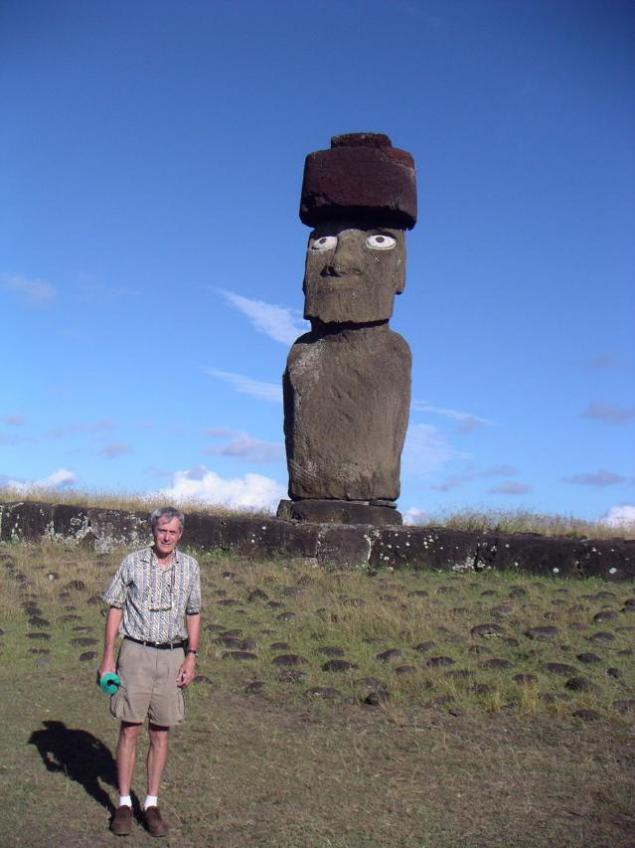
Around the middle of the 14th century manufacturing technology has changed the idols. They were made from volcanic tuff (colloquially, pumice) in the career of an extinct volcano Rano Raraku. It was then purchased the statue and its canonical form. Sculptures significantly added to the growth began to reach 10-12m height and their weight closer to 20t. In 1868. the British tried to take a sample of architecture Easter Island home, but could not even move them. After numerous attempts to transport Full sculpture sailors left these intentions, and cost 2, 5m bust, which to this day can be seen at the British Museum. But the most large statue of more than 21m in height and weighing 100 tons approaching, and remained unfinished. It can be observed in a quarry, where it is lying with the start of production.
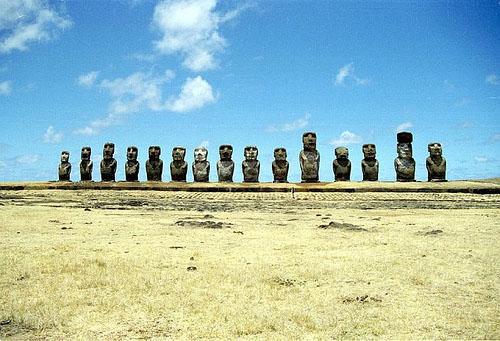
Despite the fact that all the sculptures have similar proportions and the large number of common features, each of them is unique, her personality traits. It is interesting that all articles are elongated earlobes. This feature has given rise to some researchers say that the idols - not people, and aliens. In fact, long ears - just an optical illusion. Head idols extremely stretched, according to the canons of the local tradition, because of this and it seems that the upper part of the ear is located at the crown.
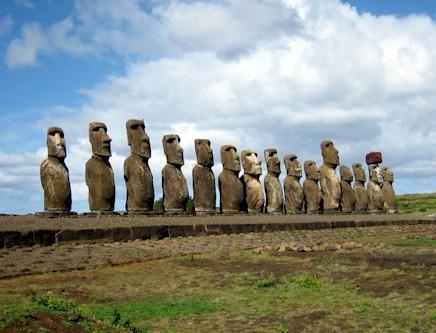
The sculptors of Easter Island.
The unusual appearance of the moai creates multiple versions of the origin of the sculptures. Some researchers put forward absolutely fantastic version, for example, assuming that the manufacturers of these monuments were mythical characters (Atlanta), or even space aliens. But in fact, tuff statues - the handiwork of "paskhaltsev." And it remained ample evidence. In the crater of Rano Raraku is there still a kind of workshop for making idols. The matter was put on stream. Residents of the island at the same time worked on the production of a large number of articles. Many unfinished idols in various stages of readiness are in the quarry. Work on some of them stopped due to detect defects in the material: cracks in the rock inclusions or hardwood, do not give the possibility to carve the nose or chin idol. Other thrown at various stages of the work, and there are almost shapeless lumps, and nearly finished products. More than 300 moai were left unfinished because the islanders for unknown reasons, suddenly stopped sculpting statues and abandoned mine forever.
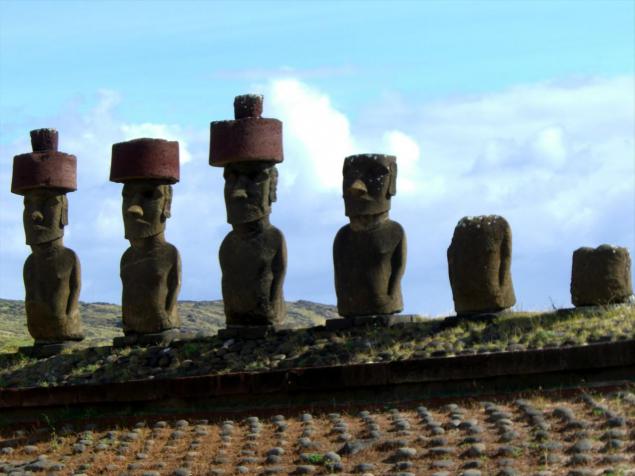
Moai are made as follows: initially tuff carving the face, ears and hands and then with a bushy finger joints below the abdomen. Then the sculptors formed back pieces, cutting down the sides of the stones. Still connected back to the main statue of polished rock, and then cut the spinal cord and the finished product is lowered down to the foot of the volcano. In the accumulated over centuries of work tonnes of waste fragments and stone-cutting activities tore a hole where almost ready to become established. The upright finished finishing neck and back idol, and then subjected to a final figure of polishing with pumice, and was ready to be transported to the installation site.
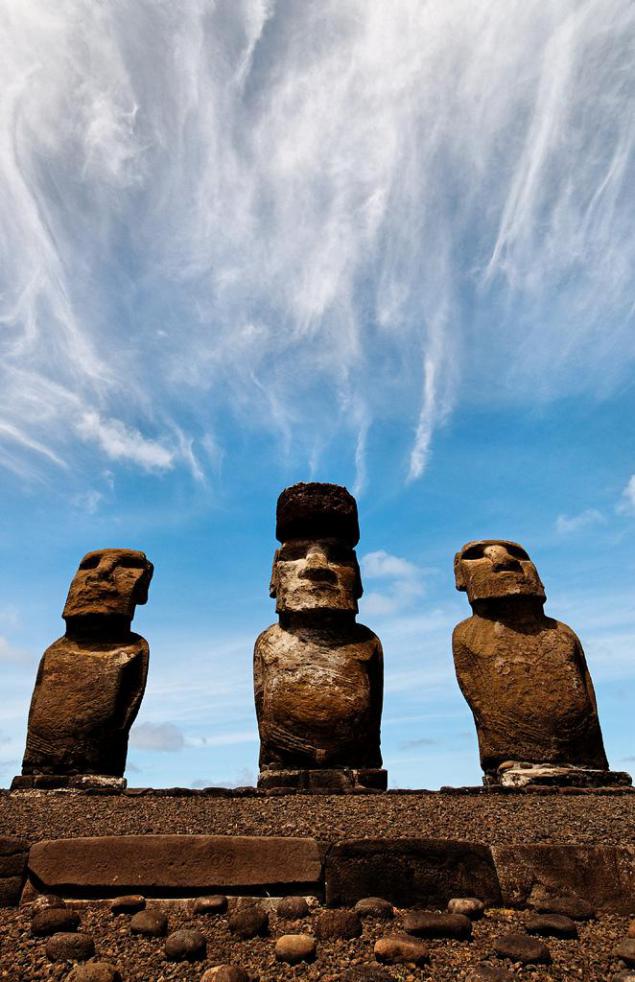
To work on idols masters used a set of stone chopping of different sizes, made of basalt. The shape of the ax reminded bit, on average, they have a length of 30-40 cm, but others reached and meter. It is difficult to say how long it takes the creative process. Thor Heyerdahl, who has spent a lot of time exploring Easter Island, together with the descendants of stone masons, decided to find out experimentally. Replacing each other, two teams kamnerezchikov produced the outlines of the figures. On this they took a year of work. The finished statue is still required to deliver to the installation site, which is also required and effort and time. How did this happen?
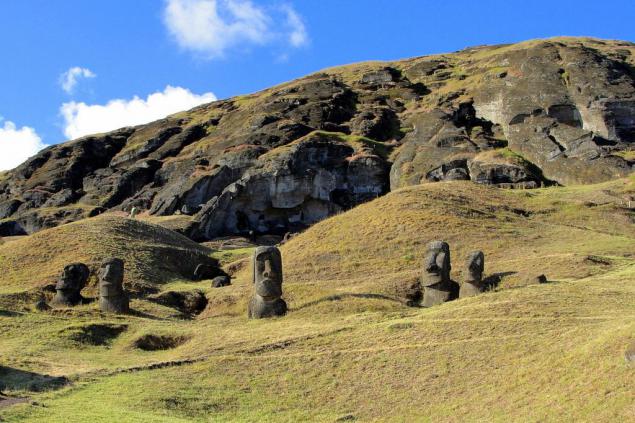
Walking giants.
Of all the technical means that could help in the process of transporting multi-ton statues, the islanders had only let the ropes of tree trunks from which manufactured rollers and levers. Maybe when transporting the water could be made of the same wood raft or a large cargo boat? In any case, the descent of heavy statue down from the slope of the volcano, transporting it to a few kilometers, and the subsequent rise in the ceremonial platform Ahu demanded the small population of the island Herculean effort. There is a hypothesis that the center of gravity of the statues were designed in such a clever way that the tilted state kantuemy with ropes, the idol could move almost independently walk. For these purposes, the pedestal was made shapes are not flat but slightly convex. An indirect confirmation of this hypothesis is the legend that tells that to the installation of the statue traveled under its own power. Experimentally, it has proved a Czech engineer Pavel Pavel, with a team of professionals consisting of 17 people, he was able to make the moai to walk in the right direction.
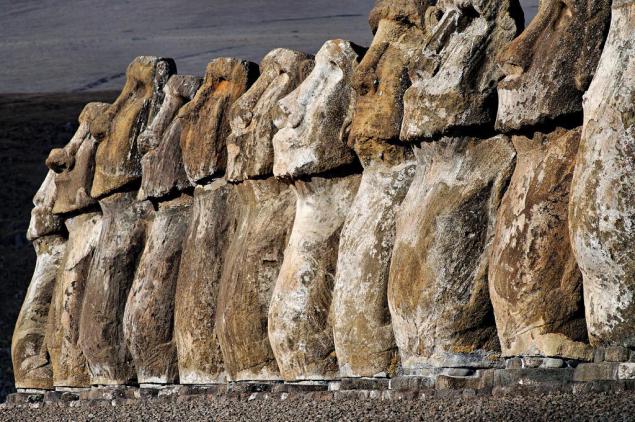
His place on the prepared dais, took the statue after it was made by an artificial mound, comparable to the height of the pedestal itself. Delivery and installation of the pedestal does not signify the end of the work on the stone idols. Already in place sculpture "brought to mind", like the sea liners, for which launching does not mean the end of work on it. Installed on the ahu giants had yet to find "hair" - a kind of multi-ton cap or crown "farts". The version that it was the hair, not the hat, appeared thanks to color bunch - it is red, and the majority of the ancient inhabitants of the islands were redheads. Stone for the manufacture of a single part of a non monolithic idols of Easter Island was mined in the crater of the volcano Puna Pau. To have survived about 90 pieces of scalps.
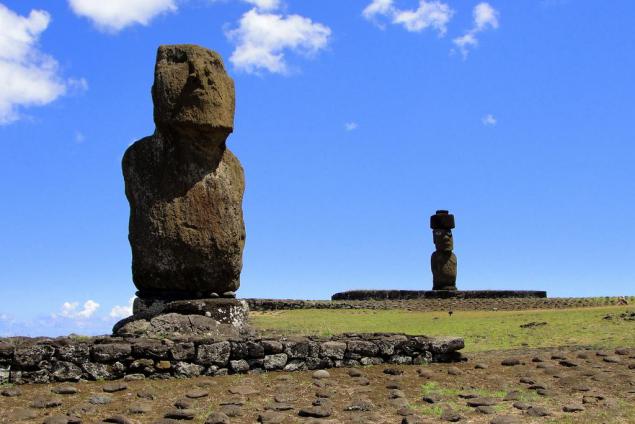
After installing rock hairstyles, there comes the final stage of work on the sculpture. At this stage, the statue hew impressive size of the orbit. The eye sockets were inserted into the eye, made of shells, coral and obsidian. According to legends, only having caught the eye could survey the idol in the place where he found himself. I believed in the fact that energy comes through the eyes of the soul, paskhaltsy giving bodies of the statues, as if enlivened them. Currently, several restored article looks at the mysterious world of coral eyes.
Falling idols.
By unknown reasons, certainly, Easter Island caught some catastrophe. Arrived here in the 18th century Europeans discovered the island idols overturned, lying on the ground. Although as recently as the opening of the Easter Island statues still standing upright, lying as they should face inland. What disasters have overthrown the old gods and leaders with their pedestals?
There are several theories that. The most plausible is this: as a result of climate change, the island has no natural fresh water resources, has undergone prolonged severe drought. As a result, paskhaltsy lost all forests of sandalwood, hibiscus, toromiro, coconut trees, and so on. E. To the last tree. Missing the trees, of course, could neither give shade or retain moisture in the soil, or to protect crops from burning dry wind. On the island loomed a terrible famine, and build a boat to leave became inhospitable to life was no longer the land of which - the trees are gone. Cut off from the rest of the world, the island was doomed to extinction. In this situation, tribal chiefs demanded from nationals of additional efforts to please the gods.
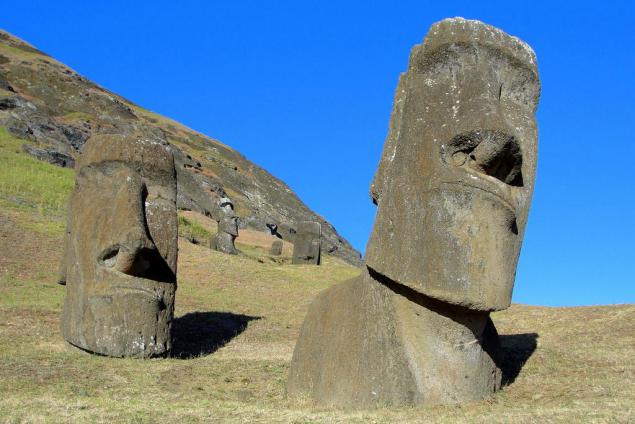
Therefore, it was necessary to make more moai, more and more impressive already existed. The titanic efforts made in this direction, to no avail. The people rebelled. Clashes between tribes inhabiting the island, the ceremonial site Ahu ruined, and standing statues of them overturned and smashed. Few survivors of this terrible time, had to start all over again. "Paskhaltsam" needed a new society and a new religion, it is fundamentally different from the old have failed.
Location fallen idols took a new divine being with a bird's head. Freedom to leave the arid lands at any time through the air, inaccessible to humanity, expressed in these new beliefs. Earlier gods and heroes were instantly and permanently forgotten. The cult of the moai was left forever, and has ceased to be, in fact, a cult. Stone idols of Easter Island have become an object of curiosity of tourists and researchers studying. However, that is what attracted people to the continent to the island, which today exists only by guests. So, we can say even defeated idols continue to serve the welfare of the inhabitants of a small triangular piece of land lost in the Pacific Ocean.
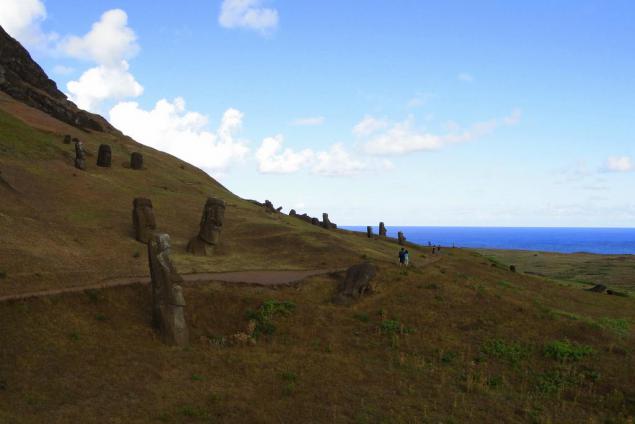
Through asceticism restorers, some sculptures have already occupied their former places on ahu, but their physical condition is worrying scientists. Statues continuously exposed to destruction under the influence of climatic factors, especially wind and rain. The main material of manufacture - tuff - is rapidly destroyed because it is more solid inclusions fall out, an idol formed dents and cracks. Moai in urgent need of conservation. Forces and means necessary for this work humanity must find quickly enough to save the future generations of these amazing sculptures of one of the most mysterious places on Earth.
via ctoday.ru
+ Photo flickr
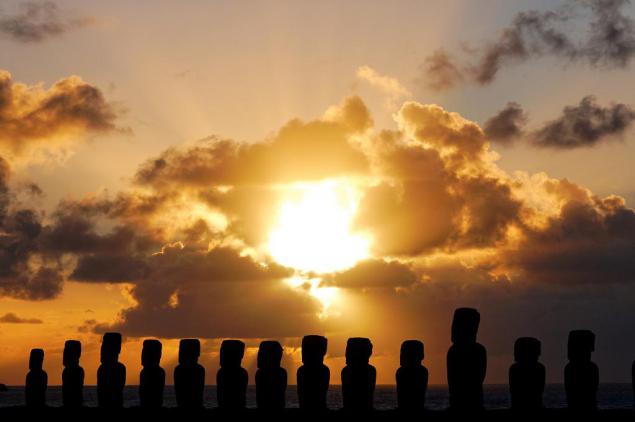
Source:
Sometimes even a small piece of land in front of people putting puzzles more than can fit in the memory of earthly inhabitants.
For example not far to seek - to 3703km from the coast of South America to the east and 1819km from the nearest inhabited islands in the west is a small triangular shaped island with an area of only 165 square kilometers.
The island has three native title - Te Pito-te-Hen, which means "Navel of the Islands", "Rapa Nui" ("Great Rapa"), and the third - "eyes looking at the sky", in the original - Mata- Kite-Rani.
Europeans piece of land called Easter Island ...

The most prominent landmark of this land is famous all over the world sculptures stone idols - moai. Total articles 997 and their appearance is so peculiar that the impressive size of the head, placed on the frail calf, the person Weighted powerful chins and long ears, can not be confused with any other human creations. Some sculptures flaunt tysyachekilogrammovymi hats red. Despite the fact that the secrets of the quarries haunt people almost since the opening of the Easter Island, despite the presence of many original and ingenious theories, their purpose, the main issues relating to the moai, are still on the agenda: who, when, and most importantly, why I created them as multi-ton sculpture was delivered to the installation site and why they were defeated?
Who portrayed idols?
On this question, as to the question: who are devoted to the image, modern science has no exact answer. The indigenous people have lost their historical memory. In addition, almost all of the indigenous people of the island have become extinct in the 19th century, during an epidemic of smallpox, brought here from the continent. There is a theory that served as statues, tombstones, ie They are the guardians of the dead and portrayed the deceased ancestors. Other theories see tall sculptures devices for maritime orientation, because the island devoid of trees, the statues are clearly distinguishable from a distance. Someone even projected location of the moai on the star map and considers them astronomical signs. In any case, none of the theories to this day completely unproven.

Probably, like most religious objects, the purpose of the idols varies with time. Moai older were most likely images of the local gods. This is indicated by their similarity to the stone statues of Polynesian inhabitants of the Marquesas Islands. Since the 14-15th c, sculptors have settled the island in a manner began to sculpt their rulers, leaders of clans, commanders, priests and other prominent locals. That is not the image of a god or a person proves the existence of a proper name of each idol. For certain deciphered today a little more than 50 names moai. The name could be given to the statue no matter whom it represented: human spirit or god. And it could coincide with the name of the manufacturer of the sculptor sculpture. In those cases, when given at birth name was forgotten, the statue was called or common notions of "Statue of god", "Statue of sorcerer" and so on. E., Or by location, or sculptural features: "The statue near the house," "Direct moai" and etc.
Same or different?
One does not doubt in riddles idols: whoever statues were not considered as they are, no doubt, have been cult figures. The cult reigned Moai on Easter Island from 12 to 17vv. During the reporting period, a lot has happened: have changed the destination application figures, even their appearance. Constructed statues at different times differ considerably from each other in their anthropometric parameters: the shape, height and width.

The oldest statue did not exceed the height of human growth, and were made of basalt. They have very little to do with the canonical sculptures of a later period, except that the location does not change hands for centuries. Over time, these basalt products stopped all play a role in the minds of the locals, they were often used as a building material and maintenance ceremonial ahu platforms. Ahu are flat or slightly sloping to the sea area in length from ten to one hundred meters and a width of about fifty. For the most part, they are located on the coast, just separated from the water pedestal for moai in height from 3 to 6 m. Sets whether the first-born of the sculptural series of Easter on a pedestal platform, is still unclear.

Around the middle of the 14th century manufacturing technology has changed the idols. They were made from volcanic tuff (colloquially, pumice) in the career of an extinct volcano Rano Raraku. It was then purchased the statue and its canonical form. Sculptures significantly added to the growth began to reach 10-12m height and their weight closer to 20t. In 1868. the British tried to take a sample of architecture Easter Island home, but could not even move them. After numerous attempts to transport Full sculpture sailors left these intentions, and cost 2, 5m bust, which to this day can be seen at the British Museum. But the most large statue of more than 21m in height and weighing 100 tons approaching, and remained unfinished. It can be observed in a quarry, where it is lying with the start of production.

Despite the fact that all the sculptures have similar proportions and the large number of common features, each of them is unique, her personality traits. It is interesting that all articles are elongated earlobes. This feature has given rise to some researchers say that the idols - not people, and aliens. In fact, long ears - just an optical illusion. Head idols extremely stretched, according to the canons of the local tradition, because of this and it seems that the upper part of the ear is located at the crown.

The sculptors of Easter Island.
The unusual appearance of the moai creates multiple versions of the origin of the sculptures. Some researchers put forward absolutely fantastic version, for example, assuming that the manufacturers of these monuments were mythical characters (Atlanta), or even space aliens. But in fact, tuff statues - the handiwork of "paskhaltsev." And it remained ample evidence. In the crater of Rano Raraku is there still a kind of workshop for making idols. The matter was put on stream. Residents of the island at the same time worked on the production of a large number of articles. Many unfinished idols in various stages of readiness are in the quarry. Work on some of them stopped due to detect defects in the material: cracks in the rock inclusions or hardwood, do not give the possibility to carve the nose or chin idol. Other thrown at various stages of the work, and there are almost shapeless lumps, and nearly finished products. More than 300 moai were left unfinished because the islanders for unknown reasons, suddenly stopped sculpting statues and abandoned mine forever.

Moai are made as follows: initially tuff carving the face, ears and hands and then with a bushy finger joints below the abdomen. Then the sculptors formed back pieces, cutting down the sides of the stones. Still connected back to the main statue of polished rock, and then cut the spinal cord and the finished product is lowered down to the foot of the volcano. In the accumulated over centuries of work tonnes of waste fragments and stone-cutting activities tore a hole where almost ready to become established. The upright finished finishing neck and back idol, and then subjected to a final figure of polishing with pumice, and was ready to be transported to the installation site.

To work on idols masters used a set of stone chopping of different sizes, made of basalt. The shape of the ax reminded bit, on average, they have a length of 30-40 cm, but others reached and meter. It is difficult to say how long it takes the creative process. Thor Heyerdahl, who has spent a lot of time exploring Easter Island, together with the descendants of stone masons, decided to find out experimentally. Replacing each other, two teams kamnerezchikov produced the outlines of the figures. On this they took a year of work. The finished statue is still required to deliver to the installation site, which is also required and effort and time. How did this happen?

Walking giants.
Of all the technical means that could help in the process of transporting multi-ton statues, the islanders had only let the ropes of tree trunks from which manufactured rollers and levers. Maybe when transporting the water could be made of the same wood raft or a large cargo boat? In any case, the descent of heavy statue down from the slope of the volcano, transporting it to a few kilometers, and the subsequent rise in the ceremonial platform Ahu demanded the small population of the island Herculean effort. There is a hypothesis that the center of gravity of the statues were designed in such a clever way that the tilted state kantuemy with ropes, the idol could move almost independently walk. For these purposes, the pedestal was made shapes are not flat but slightly convex. An indirect confirmation of this hypothesis is the legend that tells that to the installation of the statue traveled under its own power. Experimentally, it has proved a Czech engineer Pavel Pavel, with a team of professionals consisting of 17 people, he was able to make the moai to walk in the right direction.

His place on the prepared dais, took the statue after it was made by an artificial mound, comparable to the height of the pedestal itself. Delivery and installation of the pedestal does not signify the end of the work on the stone idols. Already in place sculpture "brought to mind", like the sea liners, for which launching does not mean the end of work on it. Installed on the ahu giants had yet to find "hair" - a kind of multi-ton cap or crown "farts". The version that it was the hair, not the hat, appeared thanks to color bunch - it is red, and the majority of the ancient inhabitants of the islands were redheads. Stone for the manufacture of a single part of a non monolithic idols of Easter Island was mined in the crater of the volcano Puna Pau. To have survived about 90 pieces of scalps.

After installing rock hairstyles, there comes the final stage of work on the sculpture. At this stage, the statue hew impressive size of the orbit. The eye sockets were inserted into the eye, made of shells, coral and obsidian. According to legends, only having caught the eye could survey the idol in the place where he found himself. I believed in the fact that energy comes through the eyes of the soul, paskhaltsy giving bodies of the statues, as if enlivened them. Currently, several restored article looks at the mysterious world of coral eyes.
Falling idols.
By unknown reasons, certainly, Easter Island caught some catastrophe. Arrived here in the 18th century Europeans discovered the island idols overturned, lying on the ground. Although as recently as the opening of the Easter Island statues still standing upright, lying as they should face inland. What disasters have overthrown the old gods and leaders with their pedestals?
There are several theories that. The most plausible is this: as a result of climate change, the island has no natural fresh water resources, has undergone prolonged severe drought. As a result, paskhaltsy lost all forests of sandalwood, hibiscus, toromiro, coconut trees, and so on. E. To the last tree. Missing the trees, of course, could neither give shade or retain moisture in the soil, or to protect crops from burning dry wind. On the island loomed a terrible famine, and build a boat to leave became inhospitable to life was no longer the land of which - the trees are gone. Cut off from the rest of the world, the island was doomed to extinction. In this situation, tribal chiefs demanded from nationals of additional efforts to please the gods.

Therefore, it was necessary to make more moai, more and more impressive already existed. The titanic efforts made in this direction, to no avail. The people rebelled. Clashes between tribes inhabiting the island, the ceremonial site Ahu ruined, and standing statues of them overturned and smashed. Few survivors of this terrible time, had to start all over again. "Paskhaltsam" needed a new society and a new religion, it is fundamentally different from the old have failed.
Location fallen idols took a new divine being with a bird's head. Freedom to leave the arid lands at any time through the air, inaccessible to humanity, expressed in these new beliefs. Earlier gods and heroes were instantly and permanently forgotten. The cult of the moai was left forever, and has ceased to be, in fact, a cult. Stone idols of Easter Island have become an object of curiosity of tourists and researchers studying. However, that is what attracted people to the continent to the island, which today exists only by guests. So, we can say even defeated idols continue to serve the welfare of the inhabitants of a small triangular piece of land lost in the Pacific Ocean.

Through asceticism restorers, some sculptures have already occupied their former places on ahu, but their physical condition is worrying scientists. Statues continuously exposed to destruction under the influence of climatic factors, especially wind and rain. The main material of manufacture - tuff - is rapidly destroyed because it is more solid inclusions fall out, an idol formed dents and cracks. Moai in urgent need of conservation. Forces and means necessary for this work humanity must find quickly enough to save the future generations of these amazing sculptures of one of the most mysterious places on Earth.
via ctoday.ru
+ Photo flickr

Source:
